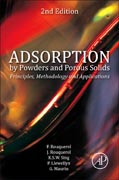
Adsorption by Powders and Porous Solids: Principles, Methodology and Applications
Rouquerol, Jean
Rouquerol, Françoise
Llewellyn, Philip
Maurin, Guillaume
Sing, Kenneth S.W.
The declared objective of this book is to provide an introductory review of the various theoretical and practical aspects of adsorption by powders and porous solids with particular reference to materials of technological importance. The primary aim is to meet the needs of students and non-specialists who are new to surface science or who wish to use the advanced techniques now available for the determination of surface area, pore size and surface characterization. In addition, a critical account is given of recent work on the adsorptive properties of activated carbons, oxides, clays and zeolites. Key Features Provides a comprehensive treatment of adsorption at both the gas/solid interface and the liquid/solid interfaceIncludes chapters dealing with experimental methodology and the interpretation of adsorption data obtained with porous oxides, carbons and zeolitesTechniques capture the importance of heterogeneous catalysis, chemical engineering and the production of pigments, cements, agrochemicals, and pharmaceuticals INDICE: Preface List of main symbols 1. Introduction 1.1. Importance of adsorption 1.2. Historical aspects 1.3. IUPAC definitions and terminology 1.4. Physisorption and chemisorption 1.5. Physisorption isotherms 1.6. Energetics of physisorption and molecular modelling 1.7. Diffusion of adsorbed molecules 2. Thermodynamics of adsorption at the gas-solid interface 2.1. Introduction 2.2. Quantitative expression of adsorption 2.3. Thermodynamic potentials of adsorption 2.4. Thermodynamic quantities related to the adsorbed states in the Gibbs representation 2.5. Thermodynamic quantities related to the adsorption process 2.6. Indirect derivation of the adsorption quantities of adsorption from of a series of Experimental physisorption isotherms : the isosteric method 2.7. Derivation of the adsorption quantities from calorimetric data 2.8. Other methods for the determination of differential enthalpies of gas adsorption 2.9. State equations for high pressure: single gas and mixtures 3. Methodology of gas adsorption 3.1. Introduction 3.2. Determination of the surface excess amount (and amount adsorbed) 3.3. Gas adsorption calorimetry 3.4. Adsorbent outgassing 3.5. Presentation of experimental data 4. Adsorption at the liquid-solid interface 4.1. Introduction 4.2. Energetics of immersion in pure liquid 4.3. Adsorption from liquid solution 5. The interpretation of physisorption isotherms at the gas-solid interface: the classical approach 5.1. Introduction 5.2. Adsorption of a pure gas 5.3. Adsorption of a gas mixture 6. Molecular simulation and modelling of physisorption in porous solids 6.1. Introduction 6.2. Microscopic description of the porous solids 6.3. Intermolecular potential function 6.4. Characterization computational tools 6.5. Modeling of adsorption in porous solids 6.6. Modeling of diffusion in porous solids. 6.7. Conclusions and future challenges 7. Assessment of surface area 7.1. Introduction 7.2. The BET method 7.3. Empirical methods of isotherm analysis 7.4. The fractal approach 7.5. Conclusions and recommendations 8. Assessment of mesoporosity 8.1. Introduction 8.2. Mesopore volume, porosity and mean pore size 8.3. Capillary condensation and the Kelvin equation 8.4. 'Classical' computation of the mesopore size distribution 8.5. DFT computation of the mesopore size distribution 8.6. Hysteresis loops 8.7. Conclusions and recommendations 9. Assessment of microporosity 9.1. Introduction 9.2. Gas physisorption isotherm analysis 9.3. Microcalorimetric methods 9.4. Conclusions and recommendations 10. Adsorption by active carbons 10.1. Introduction 10.2. Active carbons: preparation, properties and applications 10.3. Physisorption of gases by non-porous carbons 10.4. Physisorption of gases by porous carbons 10.5. Adsorption at the carbon-liquid interface 10.6. Low pressure hysteresis and adsorbent deformation 10.7. Characterization of active carbons: conclusions and recommendations 11. Adsorption by metal oxides 11.1. Introduction 11.2. Silica 11.3. Alumina 11.4. Titanium dioxide 11.5. Magnesium oxide 11.6. Other oxides: chromium, iron, zinc, zirconium, beryllium and uranium 11.7. Applications of adsorbent properties of metal oxides 12. Adsorption by clays, pillared clays, zeolites and aluminophosphates 12.1. Introduction 12.2. Structure, morphology and adsorbent properties of layer silicates 12.3. Pillared clays - structures and properties 12.4. Zeolites - synthesis, pore structures and molecular sieve properties 12.5. Aluminophosphate molecular sieves - structures and properties 12.6. Applications of clays, zeolites and phosphate-based molecular sieves 13. Adsorption by ordered mesoporous materials 13.1. Introduction 13.2. Ordered mesoporous silicas 13.3. Effect of surface functionalization on adsorption properties 13.4. Ordered organosilica materials 13.5. Replica materials 14. Adsorption by metal-organic frameworks 14.1. Introduction 14.2. Assessment and meaning of the BET area of MOFs 14.3. Effect of changing the nature of the ligands 14.4. Effect of changing the metal centre 14.5. Changing the nature of other surface sites 14.6. Influence of extra-framework species 14.7. Special case of the flexibility of MOFs 14.8. Towards application performances
- ISBN: 978-0-08-097035-6
- Editorial: Academic Press
- Encuadernacion: Rústica
- Páginas: 646
- Fecha Publicación: 01/10/2013
- Nº Volúmenes: 1
- Idioma: Inglés
